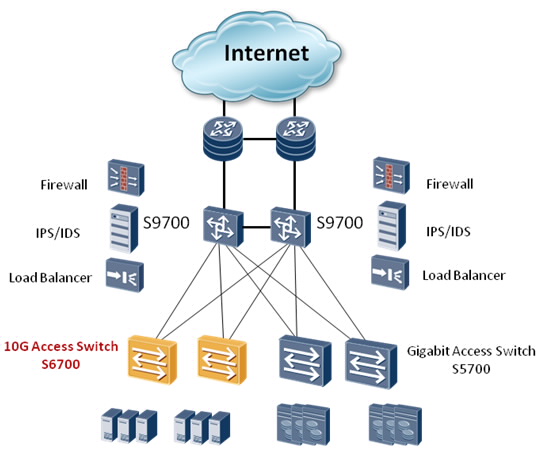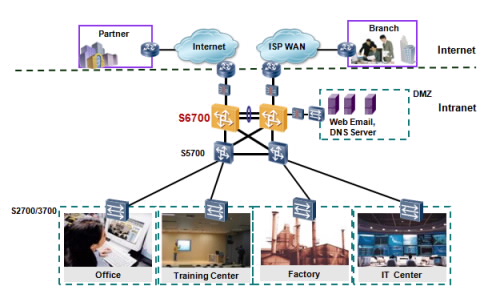Large-capacity, high-density 10 Gbit/s access
To provide sufficient bandwidth for users, many servers, particularly those in data centers, use 10G network adapters. The S6700 can be used in data centers to provide high forwarding performance and 10GE ports. The S6700 has the highest density of all 10GE ports and the largest switching capacity among its counterpart switches. Each S6700 provides a maximum of 48 line-speed 10GE ports.
S6700 ports support 1GE and 10GE access and can identify optical module types, maximizing the return on investment and allowing users to flexibly deploy services.
The S6700 has a large buffering capacity and uses an advanced buffer scheduling mechanism to ensure non-block transmission when data center traffic volume is high.
Comprehensive security policies
The S6700 provides multiple security measures to defend against Denial of Service (DoS) attacks, as well as attacks against networks or users.
The S6700 supports DHCP snooping, which generates user binding entries based on users' access interfaces, MAC addresses, IP addresses, IP address leases, and VLAN IDs.
The S6700 supports strict ARP learning, which prevents ARP spoofing attacks that exhaust ARP entries.
The S6700 supports centralized MAC address authentication and 802.1x authentication.
Higher reliability mechanisms
The S6700 supports redundant power supplies. You can choose a single power supply or use two power supplies to ensure device reliability. With two fans, the S6700 has a longer MTBF time than its counterpart switches.
The S6700 supports the enhanced trunk (E-Trunk) feature. When a CE is dual-homed to two S6700s (PEs), E-Trunk protects the links between the CE and PEs and implements backup between the PEs. E-trunk enhances link reliability between devices.
The S6700 supports the Smart Ethernet Protection (SEP) protocol, a ring network protocol applied to the link layer on an Ethernet network.
The S6700 supports Ethernet Ring Protection Switching (ERPS), also referred to as G.8032. As the latest ring network protocol, ERPS was developed based on traditional Ethernet MAC and bridging functions and uses mature Ethernet OAM function and a ring automatic protection switching (R-APS) mechanism to implement millisecond-level protection switching. ERPS supports various services and allows flexible networking, helping customers build a network with lower OPEX and CAPEX.
The S6700 supports VRRP. Two S6700s can form a VRRP group to ensure nonstop reliable communication. Multiple equal-cost routes to upstream devices can be configured on the S6700 to provide route redundancy. When an active route is unreachable, traffic is switched to a backup route.
Enhanced QoS control mechanism
The S6700 implements complex traffic classification based on packet information, such as the 5-tuple, IP preference, ToS, DSCP, IP protocol type, ICMP type, TCP source port, VLAN ID, Ethernet protocol type, and CoS. ACLs can be applied to inbound or outbound directions on an interface.
High scalability
The S6700 supports the iStack function, which allows switches that are far apart to form a stack. A port on the S6700 can be configured as a stack port using a command for flexible stack deployment. The distance between stacked switches is further increased when the switches are connected with optical fibers.
Convenient management
The S6700 supports automatic configuration, plug-and-play, deployment using a USB flash drive, and batch remote upgrades. These capabilities simplify device management and maintenance and reduce maintenance costs.
The S6700 supports SNMP v1/v2/v3 and provides flexible methods for managing devices. Users can manage the S6700 using the CLI, Web NMS, Telnet, and HGMP.
The S6700 supports GARP VLAN Registration Protocol (GVRP), which dynamically distributes, registers, and propagates VLAN attributes to reduce network administrator workloads and ensure correct VLAN configuration.
The S6700 supports Multiplex VLAN (MUX VLAN). MUX VLAN isolates Layer 2 traffic between interfaces in a VLAN.
The S6700 supports BFD, which provides millisecond-level fault detection for protocols, such as OSPF, IS-IS, VRRP, and PIM, to improve network reliability.
Various IPv6 features
The S6700 supports IPv4/IPv6 dual stack and can migrate from an IPv4 network to an IPv6 network. S6700 hardware supports IPv4/IPv6 dual stack, IPv6 over IPv4 tunnels (including manual tunnels, 6to4 tunnels, and ISATAP tunnels), and Layer 3 line-speed forwarding.
The S6700 supports various IPv6 routing protocols including RIPng and OSPFv3.
1 Data Centers
The S6700 can be used in Huawei's sustainable data center solution, which has four major highlights: evolution, availability, pooling, and visualization.
As shown in the following figure, the S9700 Terabit routing switches function as core switches in a data center and use firewall and load balancer boards to ensure security and perform load balancing. The S6700s function as access switches and provide high-density 10GE ports to connect to 10G servers.

2 Campus Networks
The S6700 can function as a core switch on a campus network and provide high-density line-speed 10GE ports, rich service features, and comprehensive security mechanisms. This makes the S6700 a cost-effective option.






















